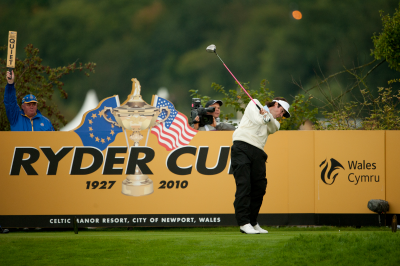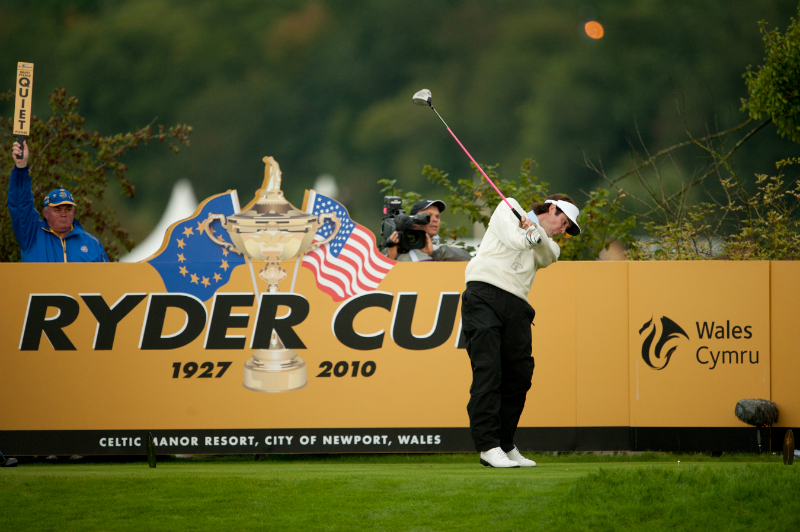
One of the enduring snapshots in Ryder Cup history is Seve Ballesteros spraying his teammates with an oversized magnum of champagne after the Europeans’ first victory on American soil in 1987 at Muirfield Village.
Ballesteros, who died last year of brain cancer, had a way of getting under the skin of his United States rivals and he ruffled more than a few feathers by rubbing it in at the home course of Jack Nicklaus, the captain of the U.S. team that year.
In the process, he helped change the Ryder Cup forever, for better or worse.
“Seve convinced us that we could beat the Americans,” Nick Faldo said.
This year’s European captain, Jose Maria Olazabal, who often teamed with Ballesteros, is bound to inspire his team with the memory of his old friend in the 39th Ryder Cup at Medinah Country Club, outside of Chicago, on Sept. 27-30.
RELATED: U.S. Ryder Cuppers relish the opportunity to represent America
Ballesteros, Olazabal and Faldo were vital members of a European cadre, which also included Sandy Lyle, Colin Montgomerie, Ian Woosnam and Bernhard Langer, who turned the tide in the biennial matches. Before the Euros won in England in 1985, the U.S. had lost only three times in Ryder Cup history, which dates to 1928.
Originally, the matches pitted the U.S. against Great Britain, which added Ireland in 1973 and all of continental Europe in 1979. The matches weren’t held in 1939, 1941, 1943 and 1945 because of World War II, and the 2001 matches were pushed back a year because of 9/11.
Even though the Americans hold a 25-11-2 lead in the series, the Euros have an 8-4-1 edge since 1985, and much of the credit is given to Ballesteros for the turnaround. The Spaniard posted a 20-12-5 record in eight Ryder Cups, including 10-3-2 as the Euros went 2-0-1 in 1985, 1987 and 1989. He also captained the Europeans to a victory in 1997 at Valderrama, the only time the event was played in Spain.
But his impact goes beyond the numbers.
“His desire to beat the Americans was paramount and probably the reason they beat us,” Tom Watson said. “The Ryder Cup became the focus of world golf, and Seve was right there as the leader.”
Ballesteros wore his heart on his sleeve and made people care about the Ryder Cup, which has grown from an event barely on the radar in the sports world to a competition that ranks with the four majors, at least in the United States and Europe, where they really take it seriously.
U.S. captain Ben Crenshaw – always an emotional guy – added plenty to his stint as captain in 1999 when he met the media after the Europeans had amassed a 10-6 lead heading into the Sunday singles.
“I’m going to leave y’all with one thought and then I’m going to leave,” Crenshaw said. “I’m a big believer in fate. I have a good feeling about this. That’s all I’m going to tell you.”
Montgomerie saw a few writers later in the evening and told them: “It’s all over, you know.”
But it really wasn’t, and the rest is history.
The lasting images of the final day are of Tom Lehman running across the green after making a birdie putt in his 3-and-2 victory over Lee Westwood; of Duval fist-pumping with his shirttail hanging out after a 5-and-4 trouncing of Jesper Parnevik; and of everybody running on the 17th green. That final incident came after Justin Leonard, who was 4 down through 11 holes, sank a 48-foot birdie putt to clinch a half point against Olazabal and give the Americans an improbable 14.5-13.5 victory.
The Americans were trashed by the European media for the incident because Olazabal still had to putt, but sportsmanship on the other side of the coin was exhibited a few minutes later when Payne Stewart conceded a putt on the 18th green that gave Montgomerie, who had been razzed mercilessly by the crowd, a 1-up victory.
That was reminiscent of an incident at the 1969 Ryder Cup when Nicklaus holed a 5-foot birdie putt on the 18th hole and then conceded a 2-footer to Tony Jacklin to halve their match and leave the Ryder Cup in a 16-16 draw, with the Americans keeping the hardware.
“This is the greatest golf match you have ever seen in England,” said U.S. captain Sam Snead, an intense competitor who was not overjoyed by Nicklaus’ gesture.
And then there was “The War on the Shore” at Kiawah Island in 1991.
Earlier that year the U.S. military kicked the Iraqi army out of Kuwait in an operation known as Desert Storm, and the American team, stung by having a 0-2-1 record in the previous three Ryder Cups, approached the competition with something of a bunker mentality. At one point, Corey Pavin wore a camouflage Desert Storm baseball cap, and the crowd bought into the jingoism.
“That was the first time I’ve ever walked onto a green and heard people in the gallery saying, ‘three-putt, three-putt,’” Faldo said.
The unpleasantness was not limited to the onlookers.
Ballesteros and Olazabal, the greatest Ryder Cup team ever with an 11-2-2 record, were involved in a bitter and brilliant match against Paul Azinger and Chip Beck, who at one point admitted to accidentally, and illegally, switching golf balls.
“I can tell you we’re not trying to cheat,” Azinger said.
Responded Ballesteros testily: “Oh, no. Breaking the rules and cheating are two different things.”
It was mission accomplished for the Americans when Langer missed a 5-foot putt for par on the final hole to halve his match with Hale Irwin and give the U.S. its first victory since 1983.
The matches two years ago at Celtic Manor in Wales left Hunter Mahan in tears after he lost the clinching match to Graeme McDowell that gave the Euros their fourth victory in the previous five Ryder Cups. That will make the Americans, captained by Davis Love III, a little more desperate this time at Medinah because of the Ryder Cup’s growing stature.
Not to mention the added pressure that has made major champions wobble.
And we can blame, or thank, Seve Ballesteros for making it that way.
– BY TOM LaMARRE
Team USA:
Keegan Bradley
Jason Dufner
Jim Furyk
Dustin Johnson
Zach Johnson
Matt Kuchar
Phil Mickelson
Brandt Snedeker
Webb Simpson
Steve Stricker
Bubba Watson
Tiger Woods
Davis Love III, Captain
Fred Couples, Assistant Captain
Mike Hulbert, Assistant Captain
Jeff Sluman, Assistant Captain
Scott Verplank, Assistant Captain
Team Europe:
Nicolas Colsaerts
Luke Donald
Sergio Garcia
Peter Hanson
Martin Kaymer
Paul Lawrie
Graeme McDowell
Rory McIlroy
Francesco Molinari
Ian Poulter
Justin Rose
Lee Westwood
José María Olazábal, Captain
Thomas Bjorn, Vice Captain
Darren Clarke, Vice Captain
Miguel Angel Jimenez, Vice Captain
Paul McGinley, Vice Captain
Ryder Cup 2012 TV Schedule
Friday, Sept. 28: Day One, 5 a.m.-4:30 p.m., ESPN
Saturday, Sept. 29: Day Two, 6 a.m.-4 p.m., NBC
Sunday, Sept. 30: Day Three, 9 a.m. -3 p.m, NBC

